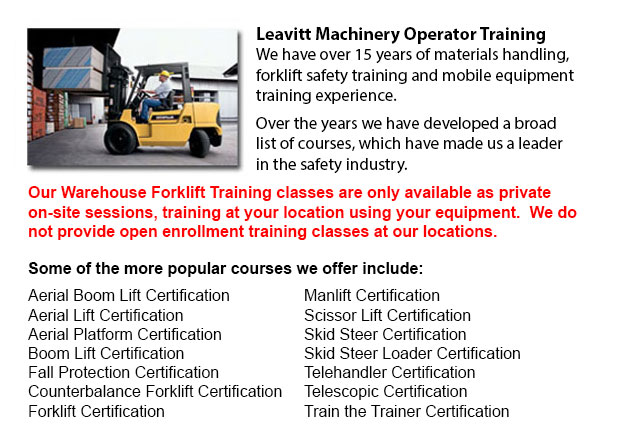
Sudbury Warehouse Forklift Safety Training - The corporation will face claims for liability when damage and injuries are sustained in an accident at the workplace. Warehouses could be a dangerous place to work for its workers, making employee safety a top priority for the business. Warehouse safety training is amongst the most effective methods to protect personnel, while minimizing costs associated with injuries and accidents.
Warehouses hold stock that can present various dangers, particularly related to materials handling. Moving stock, either manually or utilizing powered machinery, can cause injuries to workers' fingers, hands, feet and toes. Slipping, tripping and falling are common causes of injury. Heavy objects can fall off shelves and harm workers. Forklifts and other equipment carry inherent risks since they manipulate heavily laden pallets. Improper lifting is a common source of back injuries. Even splinters, box cutters and nails could result in harm.
Depending upon the goods and materials that are being handled, the conditions of the warehouse could change from one minute to the next, particularly with the equipment being used and the job being carried out. Because of the wide variety of possible dangers in warehouse settings, warehouse operations are regulated by many various standards. There are rules for material handling and storage, for walking and working surfaces, and regulations governing the use and selection of PPE (personal protective equipment).
Nearly all of the safety rules covered by a business would consist of common sense rules. Rules that warehouse employees should be quite familiar with consist of:
1. If working in a warehouse, safety is a priority at all times.
2. When work calls for proper PPE, like for example safety shoes, gloves, eye protection and hard hats, they should be worn.
3. Possible hazards must be checked and reported.
4. Know warning signs and signals - and obey them.
5. Watch where you're going and focus on what you're doing.
6. Pay attention to the work that others are doing nearby, particularly when they are working with forklifts and various dangerous machines.
7. Make sure that stacked materials and products are secured and stable.
Adherence to good housekeeping regulations will help to ensure a safe warehouse for all staff. Essential housekeeping regulations involve keeping aisles and floors clear of things, like wires and cords. Never perch things insecurely on a surface. When spills occur, clean up immediately. Throw garbage in right containers. Keep sprinklers, fire exits and fire extinguishers accessible. Put box cutters and other sharp tools away instantly after using. Report tripping hazards such as damaged or loose flooring.
-
Wheel and Track Loader Training in Sudbury
Lift trucks are obtainable in several different models that have different load capacities. The majority of average forklifts used in warehouse environment have load capacities of 1-5 tons. Bigger scale units are utilized for heavier loads, like for... More -
Sudbury Aerial Lift Certification
Sudbury Aerial Lift Certification - Aerial Lift Certification is for individuals who requires an in-depth understanding of aerial lift safety. Inspectors and operators, supervisors, maintenance workers and construction craftsmen must perform a traini... More -
Sudbury Forklift Certification Schools
Sudbury Forklift Certification Schools - Within North America, forklift certification is mandatory, making forklift training programs necessary for both the company and their employees working as forklift operators. Forklift training focuses on healt... More -
Sudbury Boom Lift Operator Training
Sudbury Boom Lift Operator Training - A cherry picker refers to a type of aerial work platform. Cherry pickers include a platform or bucket at the end of a hydraulic lifting system. The device is likewise called a man lift, boom lift, basket crane or... More -
Sudbury Telehandler Certification
Sudbury Telehandler Certification - Telehandler certification programs are both for operators who have some experience driving a standard forklift and for those with no experience. The real-world training offered by these courses produces graduates w... More -
Operator Safety Training, Re-Qualification Training, In-House Instructor Training in Sudbury
Lift trucks are utilized in just about all industrial construction sites and in warehouse operations and in boat yards. The reach feature of a lift truck is a vital component used in several applications like for example when a shelving system is bei... More -
Crane / Overhead Crane / Self-Erect Crane / Truck Mounted Crane / Hydraulic Cranes Training in Sudbury
Bridge cranes or overhead cranes are a type of industrial material handling crane making use of a line and hook apparatus which runs on a horizontal beam running along two widely separated rails. Lots of overhead cranes could be seen in a long factor... More -
Sudbury Forklift Safety Training
Sudbury Forklift Safety Training - Anyone who wants to operate a lift truck should take a forklift safety training course in order to become a certified forklift truck operator. There are a variety of ways to obtain forklift training. Programs are pr... More

Forklift Certification Sudbury
TOLL FREE: 1-888-254-6157
Sudbury, Ontario
forkliftcertificationsudbury.com
Email Us
About Us


